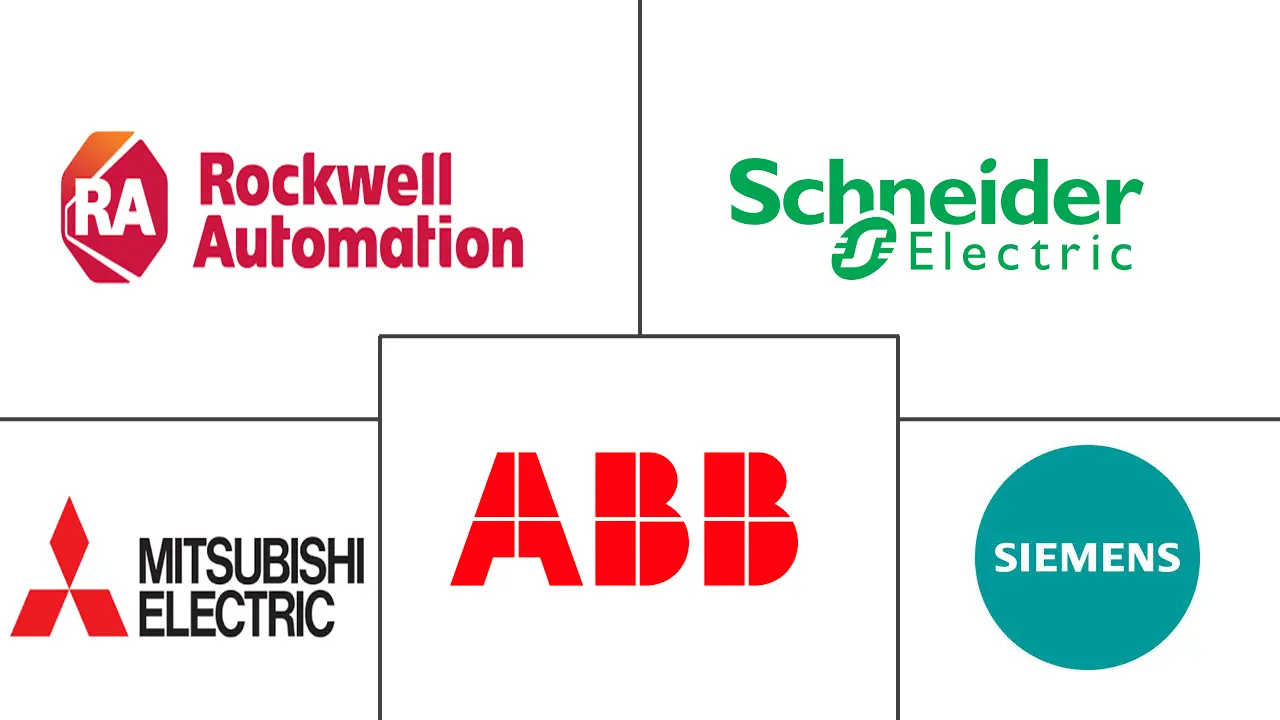
Factory Automation And Industrial Controls Market Analysis by Mordor Intelligence
The factory automation and industrial controls market size reached USD 311.90 billion in 2025 and is forecast to advance to USD 485.80 billion by 2030, translating into a 9.30% CAGR. Momentum builds as manufacturers confront talent shortages, stringent energy-efficiency rules, and the imperative to shorten supply chains. Rising labor costs encourage companies to install intelligent robotics and vision-enabled inspection cells, while energy-oriented directives in North America and the EU reward investments in high-efficiency drives and smart metering. Digital twins, edge analytics, and cloud-connected controllers form the core of next-generation factories, creating new revenue streams for service providers that overlay condition-based maintenance on top of existing hardware stacks. Meanwhile, tariff-driven redesigns of semiconductor sourcing are accelerating regional production footprints, thereby further enhancing the trajectory of the factory automation and industrial controls market. Platform vendors that blend operational-technology expertise with secure software ecosystems continue to gain pricing power, supported by government funding, such as the USD 53 billion CHIPS Act, which underwrites capital outlays for domestic fabs.[1] Cybersecurity and Infrastructure Security Agency, “Primary Mitigations to Reduce Cyber Threats to OT and ICS,” cisa.gov
Key Report Takeaways
- By product, industrial control systems held 58% of the factory automation and industrial controls market share in 2024, whereas field devices are expected to expand at a 9.8% CAGR through 2030.
- By component, hardware accounted for 62.5% of the factory automation and industrial controls market size in 2024; services posted the fastest growth at an 11.2% CAGR.
- By end-user industry, the automotive sector retained a 27% revenue share in 2024, while the pharmaceuticals sector grew at the fastest rate, with a 10.3% CAGR from 2024 to 2030.
- By control system architecture, proprietary architecture accounts for 71% of 2024 revenue; yet, open architecture is expanding at a 13% CAGR.
- By geography, Asia led with 39.4% revenue share in 2024; South America is projected to climb at a 10.1% CAGR during the outlook period.
Global Factory Automation And Industrial Controls Market Trends and Insights
Drivers Impact Analysis
| Driver | (~) % Impact on CAGR Forecast | Geographic Relevance | Impact Timeline |
|---|---|---|---|
| Industry 4.0 adoption acceleration | +2.1% | Global with Asia Pacific leadership | Medium term (2-4 years) |
| Energy-efficiency mandates & cost pressure | +1.8% | North America and European Union, spreading to Asia Pacific | Long term (≥4 years) |
| Rising labor shortages in manufacturing | +2.3% | Global, strongest in developed economies | Short term (≤2 years) |
| Government stimulus for digital factories | +1.6% | Asia Pacific (China, South Korea), European Union recovery funds, United States CHIPS-linked programs | Medium term (2-4 years) |
| Low-code / no-code automation platforms | +0.9% | North America and European Union first movers | Medium term (2-4 years) |
| AI-driven predictive quality control upgrades | +1.4% | Global, fastest adoption in high-volume manufacturing hubs | Short term (≤2 years) |
| Source: Mordor Intelligence | |||
Industry 4.0 Adoption Acceleration
Roughly 80% of global producers intend to embed Industry 4.0 solutions by 2025, yet only 10% have achieved end-to-end digitization. National programs, such as the UK’s Made Smarter grants and China’s network of 33 Manufacturing Innovation Centers, offer capital and technical guidance, pushing the factory automation and industrial controls market toward advanced analytics and autonomous optimisation. Singapore’s Smart Industry Readiness Index also helps mid-sized firms benchmark their progress, ensuring that automated mobile robots and cloud scheduling tools deliver measurable cost savings. The convergence of AI, IoT sensors, and big-data engines yields real-time insights that reduce scrap, optimize energy loads, and shorten maintenance interventions. Vendors differentiate by wrapping cybersecurity and remote-support layers around these data flows, turning routine controller sales into multi-year service annuities.
Energy-Efficiency Mandates and Cost Pressure
Governments invested more than USD 1 trillion in efficiency programs and now expect industry to shoulder a sizeable share of the global CO₂-reduction target. Factories respond by installing variable-speed drives, smart compressors, and AI-enabled scheduling platforms that shift production to off-peak renewable availability. The United Nations Economic Commission for Europe promotes industrial energy-efficiency best practices, underscoring the link between digital controls and decarbonisation. In the factory automation and industrial controls market, vendors now pre-package carbon dashboards with programmable logic controllers, turning compliance into a value-added service. As utilities raise time-of-use tariffs, fast-payback projects such as intelligent lighting and heat-recovery systems climb the corporate capital list.
Rising Labor Shortages in Manufacturing
Retirements and declining participation leave the global shop-floor workforce short by more than 2 million positions through 2030. Enterprises escalate automation rollouts, noting that 54% of investment plans target repetitive tasks, while 75% of executives highlight a growing need for data-centric roles to manage new technologies . In Japan, demographic headwinds spur autonomous vehicles and AI-guided construction equipment that later migrate to global manufacturing lines . Cost-benefit analyses show 20-30% labor-cost savings when robotics team with human operators, encouraging small plants to deploy collaborative arms and automated guided vehicles.
Low-Code / No-Code Automation Platforms
Low-code toolkits enable process engineers to configure dashboards and exception-handling logic without requiring deep coding skills, thereby compressing deployment lead times and easing maintenance backlogs. Modern MES suites embed graphical workflow builders that sit on secure, standards-based data layers, limiting the risk of ungoverned shadow applications. Citizen-developer programs multiply subtle optimisation projects, ranging from automated changeover sequences to customised quality alerts, expanding the addressable base of the factory automation and industrial controls market.
Restraints Impact Analysis
| Restraint | (~) % Impact on CAGR Forecast | Geographic Relevance | Impact Timeline |
|---|---|---|---|
| High upfront CAPEX of automation projects | -1.4% | Global, toughest for SMEs | Short term (≤2 years) |
| Cyber-security vulnerabilities in OT networks | -1.1% | Global, critical infrastructure | Medium term (2-4 years) |
| Fragmented interoperability standards | -0.9% | European Union and Asia Pacific multi-vendor environments | Medium term (2-4 years) |
| Semiconductor supply volatility for controllers | -1.2% | Global, strongest impact in Asia Pacific-led electronics supply chains | Long term (≥4 years) |
| Source: Mordor Intelligence | |||
High Upfront CAPEX of Automation Projects
Comprehensive automation programs often exceed traditional budgeting cycles, especially for small and mid-sized enterprises. Sector M&A multiples reached 18 times EBITDA in 2024, raising vendor pricing expectations and extending break-even horizons. Universal baseline import tariffs of 10%, plus a 50% duty on Chinese semiconductors, elevate component costs and complicate ROI math for capital programmes. While public grants under the CHIPS Act defray some expenses, managers still contend with training outlays and integration risks that may disrupt production during cut-overs.
Cyber-Security Vulnerabilities in OT Networks
Ransomware volumes rose 46% year-on-year, with industrial control systems a favourite entry point.[3] Critical infrastructure is now subjected to 13 attacks per second, a statistic that compels plant operators to reassess their network topologies and segmentation policies. CISA urges the disconnection of non-essential OT assets from public networks, credential hardening, and strict patching schedules. Guidance notwithstanding, legacy equipment and vendor heterogeneity slow remediation efforts, making managed-security-as-a-service a high-growth pocket within the factory automation and industrial controls market.
Segment Analysis
By Product: Control Systems Lead, Field Devices Accelerate
Industrial control systems secured 58% of the factory automation and industrial controls market in 2024, underscoring their role as the operational backbone for continuous and discrete manufacturing. Distributed control systems, SCADA, and modern PLCs integrate AI-powered diagnostics that pre-empt downtime events and synchronise with enterprise resource planning for just-in-time sequencing. Demand intensifies in semiconductor fabrication and battery cell assembly, areas that rely on microsecond-level loop execution to achieve defect-free throughput. At the same time, the factory automation and industrial controls market size attributed to field devices is projected to expand at a 9.8% CAGR to 2030, driven by advances in smart cameras and collaborative robotics that incorporate self-learning algorithms near the production line.
Machine-vision platforms move beyond simple presence checks toward 3D measurement of complex contours, enabling in-line correction rather than post-process rework. Industrial robots, once fenced, now share workspace with humans, guided by safe-motion firmware and proximity sensors. These capabilities lower integration barriers and open fresh opportunities in industries with shorter product cycles. Sensor manufacturers push higher-resolution, lower-power designs that feed real-time vibration, acoustic, and thermal signatures back to the control layer, reinforcing predictive-maintenance models that stretch asset life and limit unplanned outages.
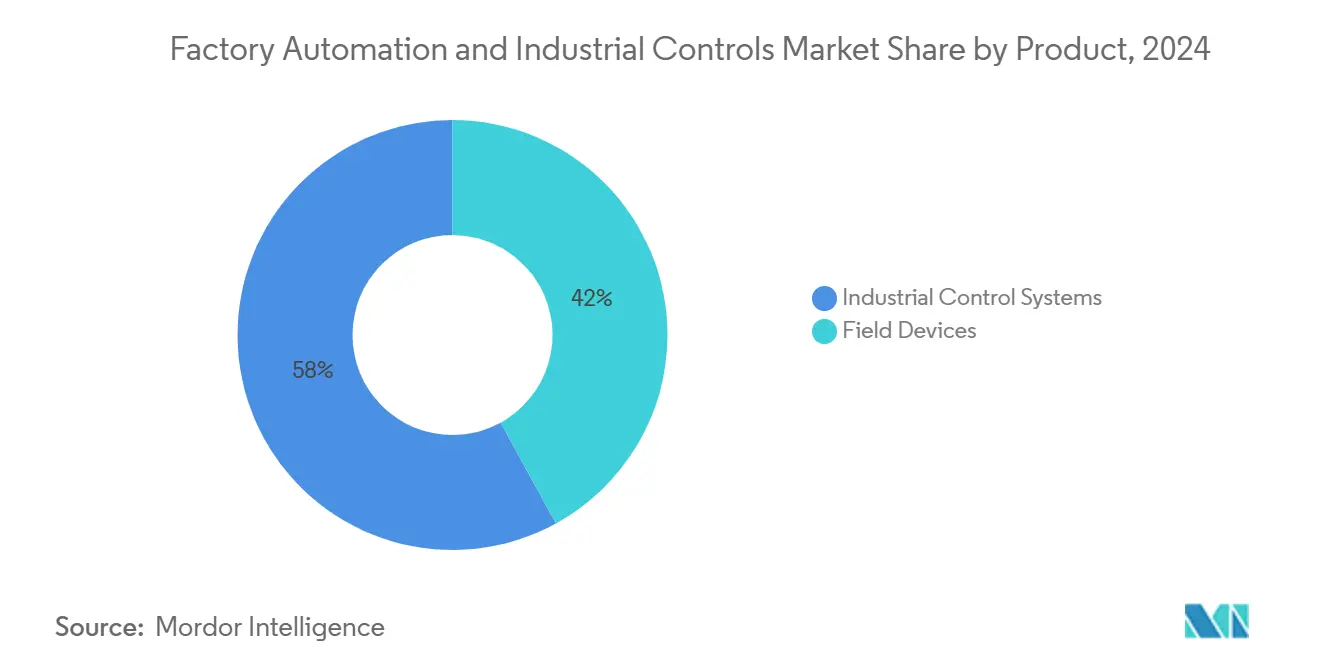
Note: Segment shares of all individual segments available upon report purchase
By Component: Hardware Dominance, Services Surge
Hardware generated 62.5% of the factory automation and industrial controls market size in 2024 as companies refreshed aging controllers and servo drives to handle faster cycle times and tighter tolerances. Nevertheless, service revenues are climbing 11.2% per year, reflecting management’s preference for outcome-based contracts that de-risk technology adoption. Multi-year agreements often bundle installation, integration, and analytics support into usage-based pricing frameworks that align vendor incentives with plant performance.
Predictive-maintenance subscriptions aggregate vibration and temperature trends, benchmarking equipment fleets against anonymised peer datasets to spotlight outliers well before catastrophic failure. System-integration houses monetise protocol converters and edge gateways that join legacy Modbus devices to cloud dashboards running on secure OPC UA links. As the installed base of intelligent sensors swells, training and change-management engagements rise in parallel, completing the shift from one-time capital transactions to annuity-style service flows within the factory automation and industrial controls market.
By End-User Industry: Automotive Leads, Pharmaceutical Accelerates
Automotive lines represented 27% of factory automation and industrial controls market share in 2024, anchored by the electrification cycle that demands high-precision laser welding, battery cell stacking, and automated end-of-line testing. Flexible manufacturing cells accommodate frequent model launches and retrieval of historical energy-consumption data needed for scope-3 emissions reporting. Pharmaceutical operations, meanwhile, register the fastest growth at 10.3% CAGR through 2030 as regulators push for real-time release testing and smaller batch runs tailored to personalised therapies. Projects such as Merck’s USD 300 million FLEx Center showcase modular pods controlled by cloud-based MES that shorten validation timelines and support rapid molecule changeovers.
Food and beverage producers tighten traceability from raw-material intake to palletising, deploying vision-guided robotics and automated labelling to satisfy shelf-life accuracy rules. Chemical complexes automate compressor islands and safety-instrumented systems to comply with emissions caps, while electronics manufacturers rely on sub-micron motion control for wafer etching and camera optical-alignment stations.
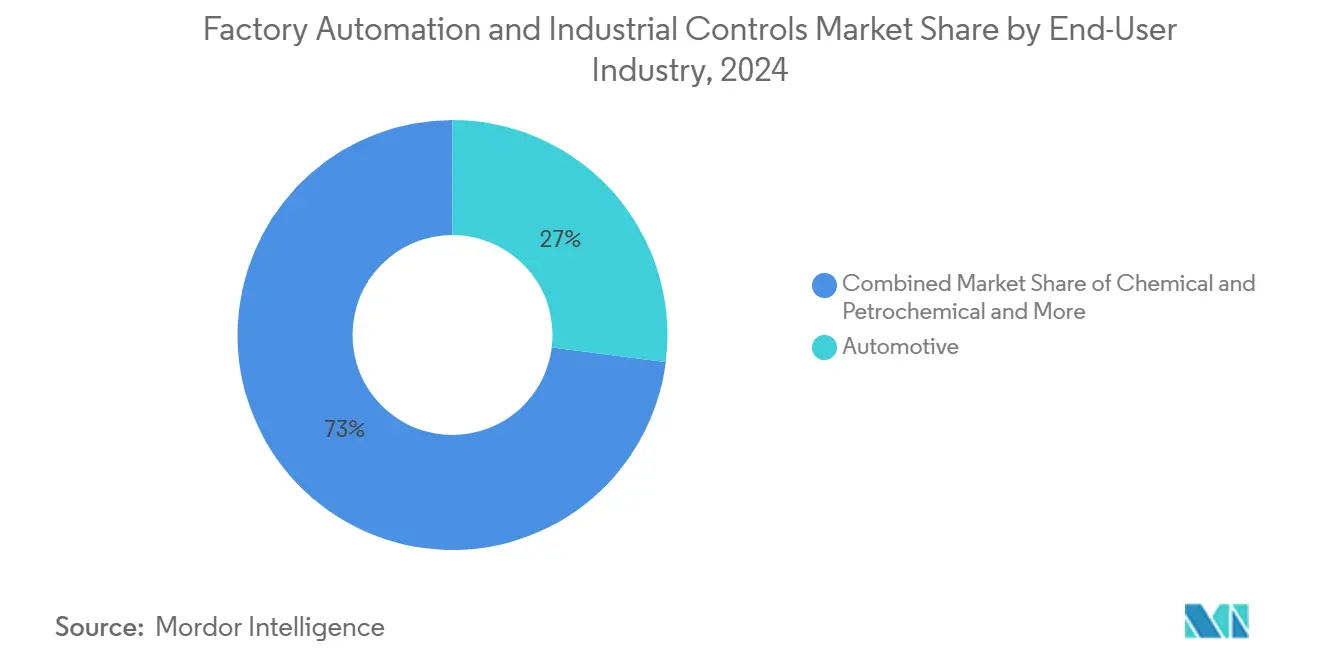
Note: Segment shares of all individual segments available upon report purchase
By Control System Architecture: Proprietary Systems Dominate, Open Standards Gain
Proprietary architectures still account for 71% of installations as of 2024 because single-vendor stacks deliver end-to-end performance guarantees and simplified support. Yet open architectures are expanding at 13% CAGR, encouraged by vendor-neutral OPC UA and Time-Sensitive Networking profiles that promise deterministic, cyber-secure traffic over standard Ethernet. Hybrid deployments permit brownfield sites to bolt interoperable gateways onto existing assets, giving managers a phased path toward full openness. Market interest in open solutions rises when multi-site enterprises negotiate groupwide service contracts and seek to avoid price escalation tied to vendor lock-in.
Standardisation bodies across Europe advocate semantic models and unified ontologies so that machines can publish contextualised data without bespoke middleware. The long-term prize is a resilient supply network where software updates propagate seamlessly and cyber patches apply across diverse equipment, lowering total cost of ownership for the factory automation and industrial controls market.
Geography Analysis
Asia captured 39.4% of 2024 revenue thanks to dense manufacturing ecosystems, skilled labour pools, and assertive digital-policy frameworks. China's 2025-era initiatives finance demonstration lines that combine AI scheduling with 5G-enabled motion control, while Japanese conglomerates deploy autonomous haulage and precision welding robots to offset chronic labour gaps.[2] Mitsui & Co. Global Strategic Studies Institute, “Targeting a Paradigm Shift Through New Technologies,” mitsui.com South Korea's chip fabrication complexes and India's smart-meter roll-outs further extend hardware demand, reinforcing Asia's central role in the factory automation and industrial controls market.
North American manufacturers accelerate investments as supply-chain sovereignty climbs the federal agenda. The CHIPS Act's USD 53 billion allotment stimulates local sensor and controller production, creating knock-on demand for secure edge-computing appliances. Universal tariffs introduced in April 2025 reinforce near-shoring, encouraging automation in small and mid-tier plants that previously relied on offshore component sourcing.
Europe focuses on sustainability and cyber-resilience. The EUR 150 billion allocation for digital transition under the Recovery and Resilience Facility (USD 163 billion) aims to modernise industrial bases, but execution gaps are leading many firms to rely on private-sector integrators to meet reporting deadlines. Compliance pressures with energy codes and supply-chain traceability hold particular sway in food, chemicals, and consumer goods plants.
South America, though starting from a smaller installed base, is projected to expand at a 10.1% CAGR through 2030. Brazil's "New Industry Brazil" program earmarks R$ 300 billion (USD 61 billion) for R&D incentives, equipment credits, and tax benefits, making automation upgrades financially attractive. Argentina's digital-factory roadmap encourages IoT pilots in agricultural machinery and food processing despite skills shortages. As cross-border technology transfer grows, regional system integrators partner with global OEMs to deliver turnkey lines suited to smaller batch volumes and variable-quality power supplies common in the region.
The Middle East and Africa join the factory automation and industrial controls market as policy makers diversify away from resource-heavy sectors. Green-field industrial zones embed predictive-maintenance platforms from inception, allowing them to leapfrog legacy architectures and focus on data-driven operations keyed to export-market compliance.
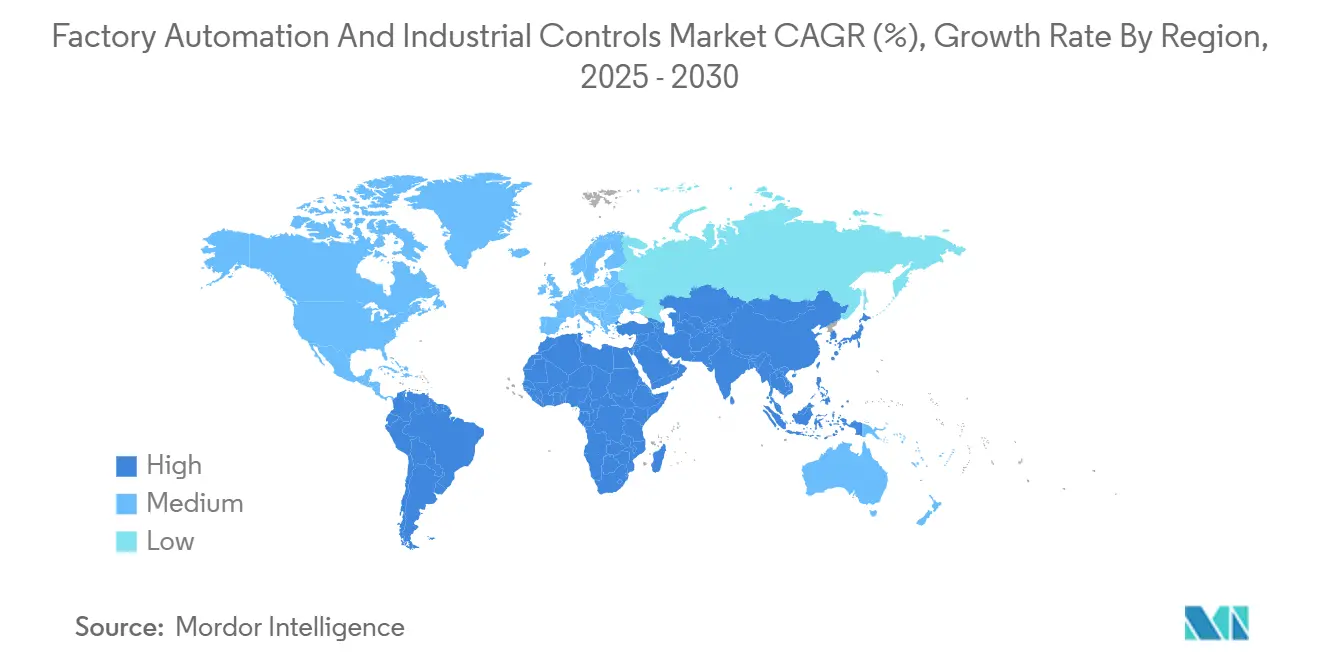
Competitive Landscape
The market shows moderate concentration, with large incumbents restructuring to sharpen strategic focus. Honeywell will split into three independent entities by 2026, enabling targeted investment in high-growth verticals such as digital industrial automation. Siemens enhanced its simulation and high-performance computing capabilities by acquiring Altair Engineering for USD 10.6 billion, a move that deepens its end-to-end digital-thread proposition. Emerson fully absorbed Aspen Technology, integrating advanced process-optimisation software into its hardware-rich portfolio to sell performance-guaranteed solutions.
Cybersecurity is now a core buying criterion. Nozomi Networks, buoyed by USD 100 million in Series E funding from OEM investors, positions its threat-intelligence platform as an OEM-agnostic overlay for heterogeneous plants. ABB answered with GMD Copilot, an AI assistant that mines real-time control-loop data to propose productivity tweaks. Private-equity inflows, reaching USD 14.87 billion in 2024, are fueling the consolidation of niche sensor and software firms, as they chase scale synergies and cross-sell to their installed bases.
Pricing power tilts toward vendors that deliver integrated offerings combining hardware, analytics, and managed security. Yet open-architecture momentum eases market entry for specialists that solve specific pain points, such as time-sensitive networking switches or low-code MES plug-ins. As interoperability progresses, switching costs decline, pressuring incumbents to innovate faster and move up the value chain via services.
Factory Automation And Industrial Controls Industry Leaders
ABB Limited
Schneider Electric SE
Rockwell Automation, Inc.
Mitsubishi Electric Corp.
Siemens AG
- *Disclaimer: Major Players sorted in no particular order
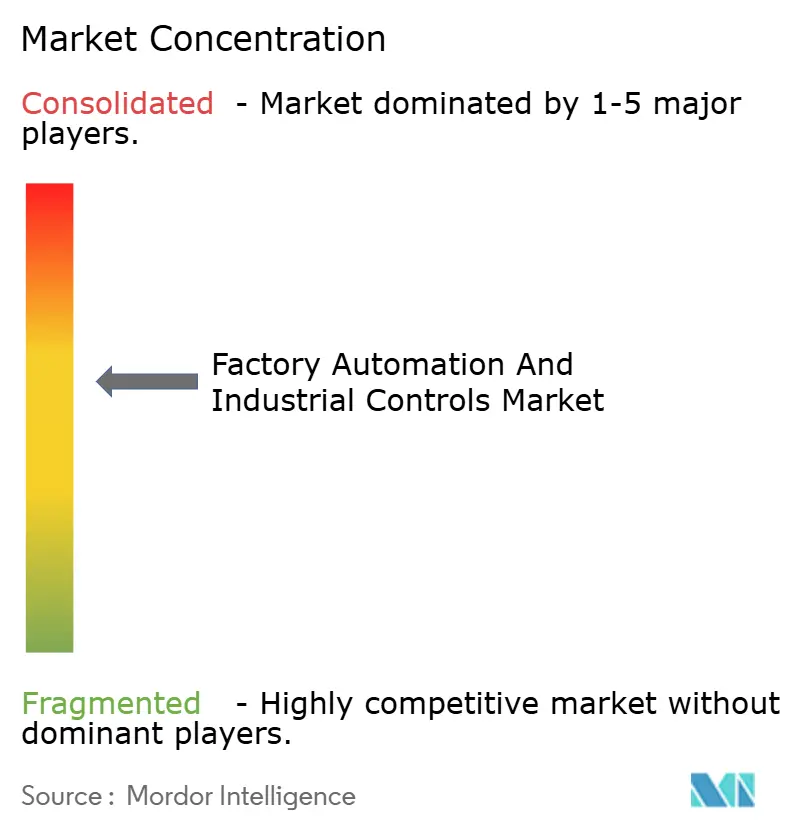
Recent Industry Developments
- January 2025: Merck commenced construction of a USD 300 million modular pharmaceutical facility in Rahway, New Jersey, embedding cloud-driven MES and flexible clean-room pods to accelerate personalised-medicine production
- January 2025: Delta Electronics enabled Phoenix Silicon International to operate the world’s first fully automated 8-inch wafer fab by integrating a DIAMES manufacturing-execution system, boosting annual capacity to 630,000 wafers
- November 2024: Rockwell Automation posted USD 8.26 billion in fiscal-year sales, a 9% decline, yet retained a USD 3.09 billion backlog that underpins service revenue visibility
- October 2024: Siemens completed the USD 10.6 billion acquisition of Altair Engineering, fortifying its digital-simulation and high-performance computing stack for industrial client
Research Methodology Framework and Report Scope
Market Definitions and Key Coverage
Our study defines the global factory automation and industrial controls market as the aggregate revenue generated from hardware, software, and services that sense, command, and optimize manufacturing or process equipment. In scope are programmable logic controllers, distributed control systems, SCADA, HMI, industrial PCs, drives, motors, robots, machine-vision systems, sensors, manufacturing execution software, and the associated engineering and maintenance services deployed across discrete and process industries.
Scope exclusions: We deliberately leave out standalone enterprise IT platforms, non-industrial building automation, and aftermarket repair parts.
Segmentation Overview
- By Product
- Industrial Control Systems
- Distributed Control System (DCS)
- Programmable Logic Controller (PLC)
- Supervisory Control & Data Acquisition (SCADA)
- Product Lifecycle Management (PLM)
- Human-Machine Interface (HMI)
- Manufacturing Execution System (MES)
- Enterprise Resource Planning (ERP)
- Other Industrial Control Systems
- Field Devices
- Machine Vision Systems
- Industrial Robotics
- Sensors and Transmitters
- Motors and Drives
- Other Field Devices
- Industrial Control Systems
- By Component
- Hardware
- Software
- Services
- By End-User Industry
- Automotive
- Chemical and Petrochemical
- Utility
- Pharmaceutical
- Food and Beverage
- Oil and Gas
- Electronics and Semiconductor
- Aerospace and Defense
- Other Industries
- By Control System Architecture
- Proprietary / Vendor-Specific
- Open / Interoperable
- Hybrid Architecture
- By Geography
- North America
- United States
- Canada
- Mexico
- South America
- Brazil
- Argentina
- Rest of South America
- Europe
- United Kingdom
- Germany
- France
- Italy
- Russia
- Rest of Europe
- Asia Pacific
- China
- India
- Japan
- South Korea
- Rest of Asia Pacific
- Middle East
- United Arab Emirates
- Saudi Arabia
- Turkey
- Rest of Middle East
- Africa
- South Africa
- Nigeria
- Egypt
- Rest of Africa
- North America
Detailed Research Methodology and Data Validation
Primary Research
To ground the numbers, we interviewed control-system integrators, plant engineers, software vendors, and regional distributors in Asia, North America, Europe, and the Gulf. Their views on project budgets, component ASP shifts, and retrofit cycles helped us adjust secondary estimates and challenge early model outputs.
Desk Research
Our desk analysis starts with tier-1 statistics from bodies such as the International Federation of Robotics, Eurostat's production index, United Nations COMTRADE (HS 8537, 8479), the U.S. Census M3 survey, and NIST ICS-CERT advisories. We enrich these with trend data from trade associations like VDMA, peer-reviewed journals tracking Industrial IoT uptake, and corporate 10-Ks that detail automation capex. We then mine D&B Hoovers for company-level revenue splits, tap Dow Jones Factiva for deal flow, and screen patent families in Questel to map innovation hotspots. This list is illustrative; many additional open and paid sources assisted our evidence build.
Market-Sizing & Forecasting
Our model first applies a top-down 'manufacturing value-added × automation intensity' construct, which is cross-checked with sampled bottom-up roll-ups of vendor shipments and channel checks. Key variables include robot installations, global PMI, average controller ASPs, electrical-energy prices, wage inflation, and plant start-ups, each forecast independently. Multivariate regression aligns these drivers with historical spend before ARIMA projections extend the trend through 2030. Where supplier roll-ups fall short, we gap-fill using calibrated penetration ratios agreed during expert calls.
Data Validation & Update Cycle
Before any figure is locked, Mordor analysts run variance checks against external benchmarks, reconcile currency conversions, and escalate anomalies for team review. Reports refresh once a year, with interim updates triggered by material events such as mega-mergers or fiscal stimulus packages, so clients always receive a current view.
Why Mordor's Factory Automation & Industrial Controls Baseline Earns Stakeholder Confidence
Published market values often diverge because studies adopt different product baskets, geographies, and price assumptions. We acknowledge this upfront and preview the usual suspects: scope breadth, base-year choice, and exchange-rate treatment that move totals.
We find gaps widen when others omit field-device revenue, apply list prices without channel discounts, or freeze models on older trade data. Mordor's broader scope, annual refresh, and dual-path validation limit such drift and give decision-makers a firmer anchor.
Benchmark comparison
| Market Size | Anonymized source | Primary gap driver |
|---|---|---|
| USD 311.9 B | Mordor Intelligence | - |
| USD 226.8 B | Global Consultancy A | Excludes field devices; minimal primary interviews |
| USD 276.6 B | Industry Data Service B | Uses list-price ASPs; 2024 base year frozen |
Taken together, the comparison shows that Mordor's disciplined scope selection, fresh primary intelligence, and transparent validations deliver a balanced baseline clients can retrace and reuse with confidence.
Key Questions Answered in the Report
What is the current size of the factory automation and industrial controls market?
The market stands at USD 311.9 billion in 2025 and is projected to reach USD 485.8 billion by 2030.
Which region leads the factory automation and industrial controls market?
Asia accounts for 39.4% of 2024 revenue, reflecting its dense manufacturing base and government-backed digitisation programs.
Which segment is growing fastest within the factory automation and industrial controls market?
Services expand at an 11.2% CAGR through 2030, driven by demand for predictive-maintenance, integration, and managed-security contracts.
How are labor shortages influencing automation investment?
Anticipated workforce gaps of over 2 million roles by 2030 push manufacturers to automate repetitive tasks and introduce collaborative robots, resulting in 20-30% labor-cost savings.
